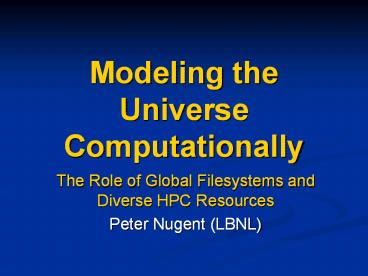Modeling the Universe Computationally - PowerPoint PPT Presentation
Title:
Modeling the Universe Computationally
Description:
Modeling the Universe Computationally The Role of Global Filesystems and Diverse HPC Resources Peter Nugent (LBNL) – PowerPoint PPT presentation
Number of Views:114
Avg rating:3.0/5.0
Title: Modeling the Universe Computationally
1
Modeling the Universe Computationally
- The Role of Global Filesystems and Diverse HPC
Resources - Peter Nugent (LBNL)
2
The acceleration is 7 years old
well more like 10 Gyr, were just slow at
figuring it out.
3
The State of the Universe
4
What to doSNAP
5
SNAP Mission
- SNAP (SuperNova/Acceleration Probe) is a proposed
3 year space-based mission to measure the nature
of Dark Energy. It will accomplish this by
determining the distances to thousands of Type Ia
Type II-P supernovae as well as weak-lensing
measurements. - 2-m telescope
- 1 billion pixels of optical CCD and N-IR
detectors - 9 filters covering the spectrum from 0.4 - 1.7
microns - Low resolution optical and N-IR spectrograph
- Two deep surveys of 7.5 sq. deg. (repeated
every 4 days for 2 years) - A single broad survey of 300 sq. deg.
6
Resolution and Data
0.5 deg.
Hubble Ultra Deep Field
7
How do we measure it?
The dynamics of space is described by the
expansion rate of the Universe as a function of
time.
An astronomical source emits a signal at time t0
which we detect now at time t1
Over this time the distance between the source
and the observer changes from d0 to d1.
Comparing the observed and absolute luminosities
of the source tells us about d1 through the
inverse square law.
Comparing the observed and emitted wavelengths of
the signal tells us about d1 / d0. This we
label the redshift.
Relating d0 to d1 tells us about the integrated
expansion rate of the Universe over that period
and repeating this for sources at different
distances tells us how the expansion rate has
changed over time.
8
Lightcurves and Spectra
9
Cosmology with SNe Ia
First year data SNLS.
10
Type II-Ps
A Type II-P is most likely a 8-15 Msolar star
that undergoes core-collapse. Unlike the II-ns
and II-Ls it is probably not in a binary system
and is not experiencing an interaction with the
circumstellar material around it.
11
EPM
Measuring Distances to Type IIs - Think EPM,
the Expanding Photosphere Method (Baade
Wesselink Method) Type II Supernovae (made
mostly of Hydrogen) are like hot, diffuse
blackbodies that expand homologously.
Velocity is measured from spectra, time is from
the explosion date. Zeta is the dilution factor -
calculated from models.
12
Hubble Diagram
- With all uncertainties factored in
- Extinction
- Explosion date
- Photometry
- Velocity
- Large MC to handle all the correlations -gt
measurement about 13 in distance.
13
Weak Lensing
14
Weak Lensing
Distortion of background images by foreground
matter
15
High Performance Computing
- HPC plays a role in all aspects of planning the
mission and eventually will be responsible for
both the operation and analysis of the data. - Data simulation
- Telescope design
- Search for systematics
- Constraining the cosmological parameters
16
High Performance Computing
- First task was to join all the disparate
computational groups that were tackling problems
related to the SNAP mission and put them under 1
repository (snap) - Simulation Kim et al.
- Weak Lensing White et al.
- Supernovae Nugent et al.
- The next task was to realize that each of these
endeavors requires different resources, some
serial, some parallel. with widely varying memory
and I/O requirements. No one computer can do it
all, thus jobs are run on pdsf, jacquard, bassi
seaborg with results written to hpss and shared,
when necessary, via the NGF.
17
Simulation
A galaxy at 25 redshifts 0.3 lt z lt 1.0
Galaxy with supernova at 16 epochs
18
Weak Lensing Systematics
19
SN Ia Systematics
Synthetic spectra from Lentz et al., based on
explosion models by Höflich et al. Observed
metallicity effects the UV (Nugent et al.) -gt
Potential effects on cosmological parameter
measurement.
UV - suppressed UV - enhanced
??
?M
?M
20
A Hole in SNe Ia?
Line of sight diversity.
Kasen et al. (2003)
21
Nearby SN Factory
Searching on Palomar Oschin Schmidt Spectrophotom
etric Follow-up w/ UH 2.2-m
22
Search Goals
Asteroids One persons garbage is anothers gold!
Pave the sky each night, 600 sq. deg. to mag
21.5 -gt 2 SNe/night 200-300 SNe Ia In the Hubble
flow over the next 3 years.
23
Discoveries80Gb/night
24
Supernovae
lt 2months worth of discoveries.
25
Data Flow
26
SNIFS
Automated follow-up, overheads 2min Leads to
about 20 science spectr night
27
SN Factory-gt SNAP
In addition to providing us with some great
science, and how to best use SNe Ia in future
missions like SNAP, it also provides a good
understanding of what is needed for the SNAP
analysis and data flow. Many future astronomy
programs are headed in this direction. The days
of a lone astronomer at the telescope making a
major discovery are numbered. A major
program/observatory with several scientific
goals, interconnected on many levels, is the wave
of the future. HPC, in a variety of forms, is
and will be used to design, operate and analyze
these investigations. Having GF in order to share
the simulation data and compare analysis tools is
crucial to the success of these programs.































